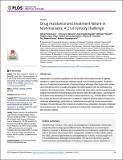Por favor, use este identificador para citar o enlazar a este item:
http://hdl.handle.net/10261/167426COMPARTIR / EXPORTAR:
 SHARE SHARE
 CORE
BASE CORE
BASE
|
|
| Visualizar otros formatos: MARC | Dublin Core | RDF | ORE | MODS | METS | DIDL | DATACITE | |

| Campo DC | Valor | Lengua/Idioma |
|---|---|---|
| dc.contributor.author | Ponte-Sucre, Alicia | es_ES |
| dc.contributor.author | Gamarro, Francisco | es_ES |
| dc.contributor.author | Dujardin, J. C. | es_ES |
| dc.contributor.author | Barrett, Michael P. | es_ES |
| dc.contributor.author | López-Vélez, Rogelio | es_ES |
| dc.contributor.author | García-Hernández, Raquel | es_ES |
| dc.contributor.author | Pountain, Andrew W. | es_ES |
| dc.contributor.author | Mwenechanya, Roy | es_ES |
| dc.contributor.author | Papadopoulou, Barbara | es_ES |
| dc.date.accessioned | 2018-07-06T10:32:03Z | - |
| dc.date.available | 2018-07-06T10:32:03Z | - |
| dc.date.issued | 2017-12-14 | - |
| dc.identifier.citation | PLoS Neglected Tropical Diseases | es_ES |
| dc.identifier.issn | 1935-2727 | - |
| dc.identifier.uri | http://hdl.handle.net/10261/167426 | - |
| dc.description.abstract | Reevaluation of treatment guidelines for Old and New World leishmaniasis is urgently needed on a global basis because treatment failure is an increasing problem. Drug resistance is a fundamental determinant of treatment failure, although other factors also contribute to this phenomenon, including the global HIV/AIDS epidemic with its accompanying impact on the immune system. Pentavalent antimonials have been used successfully worldwide for the treatment of leishmaniasis since the first half of the 20th century, but the last 10 to 20 years have witnessed an increase in clinical resistance, e.g., in North Bihar in India. In this review, we discuss the meaning of “resistance” related to leishmaniasis and discuss its molecular epidemiology, particularly for Leishmania donovani that causes visceral leishmaniasis. We also discuss how resistance can affect drug combination therapies. Molecular mechanisms known to contribute to resistance to antimonials, amphotericin B, and miltefosine are also outlined. | es_ES |
| dc.description.sponsorship | Research reported in this publication was supported by the Canadian Institutes of Health Research operating grant MOP-12182 awarded to BP; the Spanish Grant Proyecto de Excelencia, Junta de Andalucía Ref. CTS-7282 awarded to FG; the Spanish Grant SAF2015-68042-R awarded to FG; the Wellcome Trust (104111/Z/14/Z) awarded to MPB; and the Alexander von Humboldt Foundation, Germany awarded to APS. The funders had no role in study design, data collection and analysis, decision to publish, or preparation of the manuscript. | es_ES |
| dc.language.iso | eng | es_ES |
| dc.publisher | Public Library of Science | es_ES |
| dc.relation | info:eu-repo/grantAgreement/MINECO/Plan Estatal de Investigación Científica y Técnica y de Innovación 2013-2016/SAF2015-68042-R | - |
| dc.relation.isversionof | Publisher's version | es_ES |
| dc.rights | openAccess | es_ES |
| dc.subject | AMPHOTERICIN-B RESISTANCE | es_ES |
| dc.subject | PROTOZOAN PARASITE LEISHMANIA | es_ES |
| dc.subject | ABC-TRANSPORTER MRPA | es_ES |
| dc.subject | VISCERAL LEISHMANIASIS | es_ES |
| dc.subject | DONOVANI PROMASTIGOTES | es_ES |
| dc.subject | Cutaneous leishmaniasis | es_ES |
| dc.subject | MILTEFOSINE RESISTANCE | es_ES |
| dc.subject | Antimony-resistant | es_ES |
| dc.subject | MEGLUMINE ANTIMONIATE | es_ES |
| dc.subject | SODIUM STIBOGLUCONATE | es_ES |
| dc.title | Drug resistance and treatment failure in leishmaniasis: A 21st century challenge | es_ES |
| dc.type | artículo | es_ES |
| dc.identifier.doi | 10.1371/journal.pntd.0006052 | - |
| dc.description.peerreviewed | Peer reviewed | es_ES |
| dc.relation.publisherversion | http://journals.plos.org/plosntds/article?id=10.1371/journal.pntd.0006052 | es_ES |
| dc.identifier.e-issn | 1935-2735 | - |
| dc.rights.license | https://creativecommons.org/licenses/by/4.0/ | es_ES |
| dc.contributor.funder | Canadian Institutes of Health Research | es_ES |
| dc.contributor.funder | Junta de Andalucía | es_ES |
| dc.contributor.funder | Wellcome Trust | es_ES |
| dc.contributor.funder | Alexander von Humboldt Foundation | es_ES |
| dc.contributor.funder | Ministerio de Economía y Competitividad (España) | - |
| dc.relation.csic | Sí | es_ES |
| oprm.item.hasRevision | no ko 0 false | * |
| dc.identifier.funder | http://dx.doi.org/10.13039/501100003329 | es_ES |
| dc.identifier.funder | http://dx.doi.org/10.13039/100004440 | es_ES |
| dc.identifier.funder | http://dx.doi.org/10.13039/501100000024 | es_ES |
| dc.identifier.funder | http://dx.doi.org/10.13039/100005156 | es_ES |
| dc.identifier.funder | http://dx.doi.org/10.13039/501100011011 | es_ES |
| dc.contributor.orcid | Pountain, Andrew W.[0000-0001-9651-5145] | es_ES |
| dc.identifier.pmid | 29240765 | - |
| dc.type.coar | http://purl.org/coar/resource_type/c_6501 | es_ES |
| item.openairetype | artículo | - |
| item.grantfulltext | open | - |
| item.cerifentitytype | Publications | - |
| item.openairecristype | http://purl.org/coar/resource_type/c_18cf | - |
| item.fulltext | With Fulltext | - |
| item.languageiso639-1 | en | - |
| Aparece en las colecciones: | (IPBLN) Artículos | |
Ficheros en este ítem:
| Fichero | Descripción | Tamaño | Formato | |
|---|---|---|---|---|
| journal.pntd.0006052.pdf | Review | 1,68 MB | Adobe PDF |  Visualizar/Abrir |
CORE Recommender
PubMed Central
Citations
263
checked on 14-abr-2024
SCOPUSTM
Citations
551
checked on 15-abr-2024
WEB OF SCIENCETM
Citations
485
checked on 25-feb-2024
Page view(s)
291
checked on 22-abr-2024
Download(s)
231
checked on 22-abr-2024

